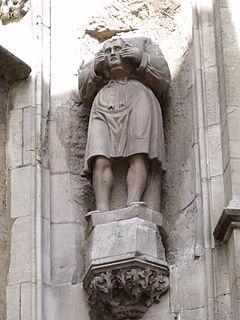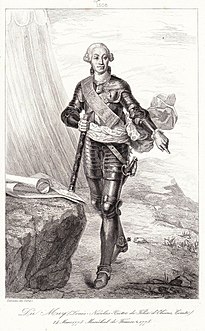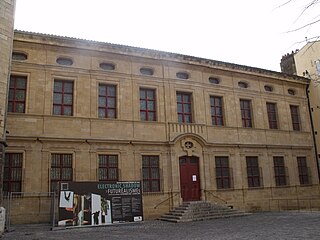
Aix-en-Provence, or simply Aix, is a city and commune in Southern France, about 30 km (19 mi) north of Marseille. A former capital of Provence, it is the subprefecture of the arrondissement of Aix-en-Provence, in the department of Bouches-du-Rhône, in the region of Provence-Alpes-Côte d'Azur. The population of Aix-en-Provence is of approximately 143,000. Its inhabitants are called Aixois or, less commonly, Aquisextains.

The Cours Mirabeau is a wide thoroughfare in Aix-en-Provence, France.

Aix Cathedral in Aix-en-Provence in southern France is a Roman Catholic church and the seat of the Archbishop of Aix-en-Provence and Arles. The cathedral is built on the site of the 1st-century Roman forum of Aix. Built and re-built from the 12th until the 19th century, it includes Romanesque, Gothic and Neo-Gothic elements, as well as Roman columns and parts of the baptistery from a 6th-century Christian church. It is a national monument of France.

Ambroise Roux-Alphéran (1776–1858) was a French public official and historian.

Mitre (433–466) was a Catholic saint, who was born in Thessaloniki, Greece, and died in Aix-en-Provence.
Jean Joseph Marius Diouloufet was a Provençal poet.

Louis Nicolas Victor de Félix d'Ollières, comte du Muy, comte de Grignan, was a French soldier and statesman from a family originating in Provence. He was made a member of the Ordre du Saint-Esprit in 1764.

The Church of St. John in Aix-en-Provence, situated at the corner of rue d'Italie and rue Cardinale, is a Gothic Roman Catholic church, the first in Provence. It was built in the 13th century, mostly in the 1270s.

The Musée Granet is a museum in the quartier Mazarin, Aix-en-Provence, France devoted to painting, sculpture and archeology. In 2011, the museum received 177,598 visitors.
Laurent Vallon (1652-1724) was a French architect, mostly active in the Provence. Many of his buildings are now listed as monuments historiques.

Jean-Pierre-François de Ripert-Monclar (1711-1773) was a French aristocrat, landowner and lawyer.

Bache-Elzéar-Alexandre d'Arbaud de Jouques (1720-1793) was a French aristocrat and public official. He served as the Governor of Guadeloupe from 1775 to 1782.

Henri Gautier (1676–1757) was a French aristocrat, landowner and public official.

The Hôtel de Gantès is a listed hôtel particulier in Aix-en-Provence. Built in 1660, it was home to a private members' club until the French Revolution of 1789, when two aristocratic members were murdered by revolutionaries. Since the 1840s, it has been home to the world-famous café, Les Deux Garçons, a haunt of artists, writers and celebrities.

Joseph Cabassol (1859–1928) was a French lawyer, politician, and banker. He served as the Mayor of Aix-en-Provence from 1902 to 1908.
Antoine Aude (1799–1870) was a French lawyer and politician. He served as the Mayor of Aix-en-Provence from 1835 to 1848.

The Hôtel Silvy is a listed hôtel particulier in Aix-en-Provence.
Charles Jean-Baptiste des Gallois de La Tour (1715–1802) was a French public official. He served as the last First President of the Parliament of Aix-en-Provence from 1748 to 1771, and from 1775 to 1790.

The Hôtel de Gueydan is a listed hôtel particulier in Aix-en-Provence, Bouches-du-Rhône, France.

Hôtel de Gallifet is an 18th-century Hôtel Particulier located in the Quartier Mazarin of Aix-en-Provence in France. Today, it serves as a contemporary art center for the public. It is located at 52 rue Cardinale in the Mazarin district of Aix-en-Provence.
















